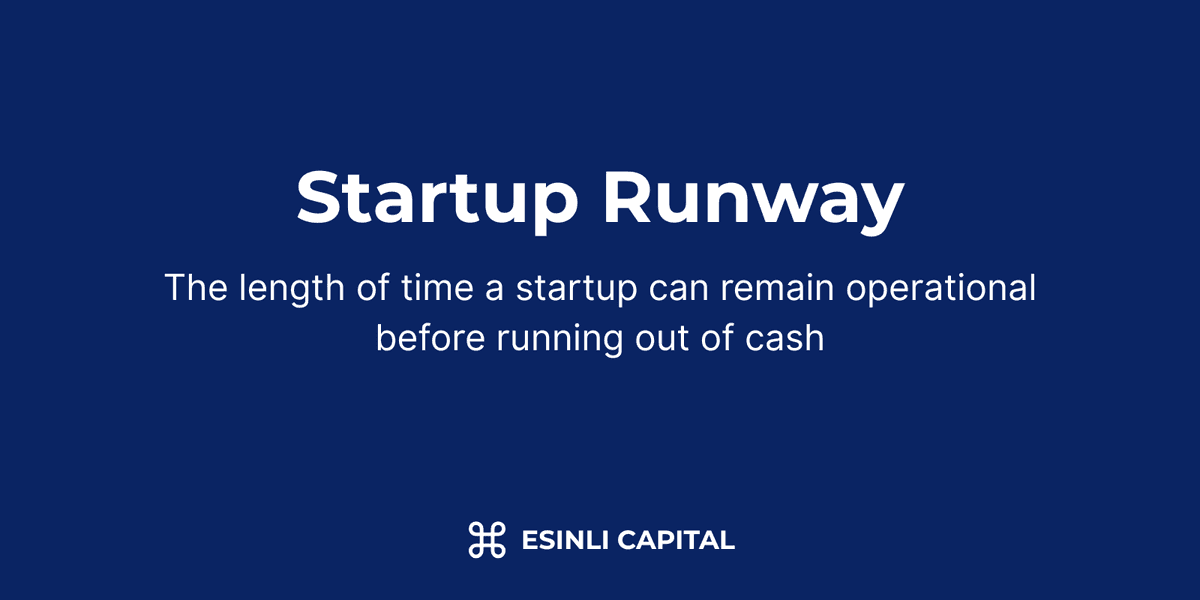
Startup Runway Calculation: Formula, Extension Strategies
KEY TAKEAWAYS
- Startup runway is calculated by dividing cash reserves by monthly burn rate, providing the number of months a company can operate before exhausting funds.
- The ideal runway for startups is typically 12-18 months, with the minimum acceptable being 6 months before initiating fundraising efforts.
- Burn rate management involves tracking both gross burn (total monthly expenses) and net burn (monthly losses after accounting for revenue).
- Extending runway requires either decreasing expenses (through cost-cutting, restructuring, or operational efficiency) or increasing revenue (via accelerated sales, pricing adjustments, or new revenue streams).
- Financial forecasting accuracy is essential for realistic runway calculations, requiring regular updates as business conditions and growth rates change.
What Is Startup Runway?
Startup runway refers to the length of time a company can remain operational before it runs out of cash, assuming no additional capital is raised. It represents a critical financial metric that helps founders and investors understand the financial health and sustainability of a startup. The runway calculation serves as a survival timer, indicating how long a business can continue functioning before it needs to either become profitable or secure additional funding.
For early-stage startups, runway is particularly crucial because most operate at a loss while building products, acquiring customers, and establishing market presence. A longer runway provides more time to achieve key milestones, demonstrate growth, and improve valuation metrics before the next fundraising round.
How to Calculate Startup Runway
The basic formula for calculating startup runway is straightforward:
Runway (in months) = Current Cash Reserves ÷ Monthly Burn Rate
For example, if a startup has $500,000 in the bank and spends $50,000 per month, its runway is 10 months.
However, accurate runway calculations require understanding several related concepts:
Gross Burn Rate
Gross burn rate represents the total amount of money a company spends each month, including all operating expenses such as:
- Salaries and benefits
- Office space and utilities
- Software subscriptions
- Marketing expenses
- Manufacturing costs
- Professional services
Net Burn Rate
Net burn rate accounts for both expenses and revenue, providing a more accurate picture of how quickly a company is consuming its cash reserves:
Net Burn Rate = Gross Burn Rate - Monthly Revenue
For example, if a startup spends $100,000 per month (gross burn) but generates $30,000 in monthly revenue, its net burn rate is $70,000.
Variable Burn Rate Considerations
Startups rarely maintain a consistent burn rate over time. Several factors can cause fluctuations:
- Seasonal business variations - Many businesses experience seasonal revenue patterns
- Growth investments - Periods of increased marketing spend or hiring
- Product development cycles - R&D expenses may vary based on development phases
- One-time expenses - Legal fees, equipment purchases, or office relocations
For more accurate runway projections, founders should calculate separate runways for different scenarios or use a rolling average burn rate from the past 3-6 months.
Startup Runway Calculation and Management
Understanding Runway in Different Startup Stages
The ideal runway length varies depending on a startup's stage of development:
Pre-seed/Seed Stage:
- Typical runway: 12-18 months
- Minimum benchmark: 6-9 months
- Focus: Product development and initial market validation
Series A:
- Typical runway: 18-24 months
- Minimum benchmark: 12 months
- Focus: Market fit confirmation and revenue growth
Series B and beyond:
- Typical runway: 24+ months
- Minimum benchmark: 18 months
- Focus: Scaling operations and approaching profitability
Warning Signs of Inadequate Runway
Founders should be alert to these indicators that runway management requires immediate attention:
- Runway below 6 months - Creates fundraising pressure that weakens negotiating position
- Consistently missing financial projections - Suggests underlying issues with financial planning
- Increasing burn rate without corresponding revenue growth - Indicates poor operational efficiency
- Delayed fundraising timeline - May result from market conditions or company performance concerns
- Customer acquisition costs rising - Signals declining marketing efficiency
Creating a Runway Extension Plan
Every startup should have a contingency plan for extending runway if fundraising is delayed or market conditions deteriorate. A comprehensive runway extension plan includes:
- Prioritized expense-cutting tiers (10%, 25%, 40%) with specific actions at each level
- Revenue acceleration initiatives that could be implemented quickly
- Alternative funding sources beyond traditional venture capital
- Key metrics triggers that would initiate the plan
- Communication strategy for stakeholders, including employees, investors, and customers
How to Extend Your Startup's Runway
Extending runway requires either decreasing expenses or increasing revenue—ideally both. Here's a systematic approach to each strategy:
Reducing Expenses
1. Optimize Headcount Expenses
Personnel costs typically represent 60-70% of a startup's burn rate. Options for reduction include:
- Implementing hiring freezes on non-essential roles
- Considering salary reductions or equity exchanges
- Exploring contractor relationships instead of full-time employees
- Analyzing team productivity and restructuring if necessary
- Delaying planned team expansions
2. Reduce Office and Administrative Costs
Physical space and administrative expenses offer significant saving opportunities:
- Downsizing office space or negotiating rent reductions
- Adopting remote or hybrid work models
- Reviewing and canceling underutilized software subscriptions
- Renegotiating vendor contracts for more favorable terms
- Delaying non-essential equipment purchases
3. Optimize Marketing Spend
Marketing budgets should be evaluated for efficiency:
- Focusing on channels with the lowest customer acquisition cost
- Reducing brand marketing in favor of performance marketing
- Implementing more rigorous attribution tracking
- Leveraging organic growth and word-of-mouth strategies
- Pausing expansion into new markets
4. Streamline Product Development
Engineering resources should be concentrated on core functionality:
- Prioritizing features with direct revenue impact
- Delaying nice-to-have improvements
- Reducing technical debt paydown initiatives
- Considering development outsourcing for specific projects
- Implementing more efficient development methodologies
Increasing Revenue
1. Accelerate Sales Processes
Shortening sales cycles immediately improves cash flow:
- Simplifying the product offering to reduce decision complexity
- Offering incentives for faster contract closings
- Implementing more efficient lead qualification processes
- Focusing sales resources on high-probability prospects
- Creating urgency through limited-time pricing or features
2. Adjust Pricing Strategy
Strategic pricing changes can significantly impact runway:
- Testing higher price points with new customers
- Implementing annual payment discounts to improve cash flow
- Restructuring pricing tiers to capture more value
- Adding premium features with higher margins
- Reducing or eliminating unprofitable discounting practices
3. Explore New Revenue Streams
Diversifying revenue sources builds financial resilience:
- Developing adjacent product offerings
- Creating professional services around your core product
- Establishing strategic partnerships with revenue-sharing components
- Licensing technology or intellectual property
- Expanding into new market segments with existing products
4. Improve Customer Retention
Reducing churn is often more cost-effective than new customer acquisition:
- Implementing proactive customer success programs
- Creating loyalty incentives and referral programs
- Developing expansion revenue opportunities within existing accounts
- Addressing common causes of cancellation
- Building community around your product
Financial Instruments for Runway Extension
Beyond operational changes, several financial instruments can extend runway:
- Venture debt - Loans specifically designed for venture-backed startups
- Revenue-based financing - Funding repaid as a percentage of monthly revenue
- Convertible notes - Short-term debt that converts to equity in the next funding round
- Customer prepayments - Discounts in exchange for annual or multi-year commitments
- Grants and tax incentives - Non-dilutive government or foundation funding
Financial Forecasting for Runway Calculation
Accurate runway calculations depend on realistic financial forecasts. Here's how to improve forecasting precision:
Creating Multi-Scenario Projections
Rather than a single forecast, develop projections for multiple scenarios:
- Base case - Most likely outcome given current trends
- Conservative case - Lower-bound estimates accounting for potential challenges
- Optimistic case - Upper-bound estimates if key initiatives succeed
- Disaster case - Worst-case scenario for contingency planning
Incorporating Growth Metrics into Runway Calculations
Static runway calculations don't account for changing business dynamics. Advanced runway modeling should incorporate:
- Revenue growth rates - How quickly monthly income is increasing
- Burn rate trends - Whether monthly expenses are stabilizing or growing
- Unit economics improvements - Changes in margins and customer acquisition costs
- Operational efficiency gains - Increased productivity per dollar spent
Regular Runway Recalculation
Runway should be recalculated at regular intervals:
- Monthly - As part of regular financial reporting
- After significant events - Major client wins, product launches, or market changes
- Prior to strategic decisions - Before committing to major investments
- When approaching fundraising - To establish accurate capital requirements
Tools for Runway Management
Several tools can assist with runway calculation and management:
- Financial modeling software - Dedicated tools like Causal, Jirav, or Finmark
- Accounting integrations - QuickBooks, Xero, or NetSuite with custom reporting
- Dashboard solutions - Databox, Geckoboard, or custom dashboards
- Burn rate calculators - Purpose-built spreadsheets or web applications
Fundraising Timing and Runway
Strategic fundraising requires understanding the relationship between runway and investor expectations.
Optimal Fundraising Timing
The ideal time to begin fundraising is determined by:
- Current runway - Starting when 6-9 months of runway remains
- Market conditions - Adjusting timing based on investor sentiment and availability
- Milestone achievement - Initiating after reaching key business objectives
- Competitive landscape - Considering competitor fundraising activities
- Seasonal factors - Avoiding traditionally slow periods (summer, December)
Communicating Runway to Investors
When discussing runway with potential investors:
- Be transparent about current runway and burn rate
- Demonstrate control through detailed understanding of financial drivers
- Present contingency plans for runway extension if needed
- Connect fundraising amounts to specific milestone achievements
- Show efficiency in how previous capital was deployed
Red Flags in Runway Management
Investors watch for these warning signs in runway management:
- Frequent changes to burn rate projections
- Unrealistic revenue forecasts not supported by historical data
- Lack of clarity about major expense categories
- Over-optimistic assumptions about sales cycles or closing rates
- Insufficient attention to unit economics
The Bottom Line
Runway calculation is more than a simple division problem—it's a fundamental practice for responsible startup financial management. By understanding and actively managing runway, founders can maintain operational flexibility, avoid desperate fundraising situations, and make strategic decisions from a position of financial clarity.
The most successful startups maintain a delicate balance between conserving runway and investing in growth. While extending runway is always possible through drastic cost-cutting, doing so at the expense of critical growth initiatives can ultimately be counterproductive. The goal should be maintaining sufficient runway while still pursuing the strategic objectives that will create long-term value.
For early-stage companies, mastering runway management is perhaps the most important financial skill. It not only prevents premature company failure but also creates the foundation for thoughtful growth and eventual profitability.
Frequently Asked Questions
What is the minimum acceptable runway for a startup?
The absolute minimum acceptable runway for any startup is 3 months, but this represents a critical situation requiring immediate action. Most investors and advisors recommend maintaining at least 6 months of runway, with 12-18 months being the ideal target range for early-stage companies.
How does revenue growth affect runway calculations?
Revenue growth extends runway by reducing the net burn rate. However, revenue projections should be based on conservative estimates with high confidence levels. Many startups make the mistake of including overly optimistic revenue forecasts in their runway calculations, creating a false sense of security.
Should I include future fundraising in my runway calculations?
No. Runway calculations should always assume no additional capital will be raised. This provides a clear picture of the company's current financial situation without depending on external factors. You can create separate projections that include potential fundraising, but these should be clearly labeled as such.
How often should I recalculate my startup's runway?
At minimum, runway should be recalculated monthly as part of regular financial reporting. However, any significant change in business conditions—major new contracts, unexpected expenses, hiring plans, or market shifts—should trigger an immediate runway recalculation.
What's the relationship between burn rate and growth rate?
The ratio between burn rate and growth rate helps determine if a startup is efficiently deploying capital. As a general benchmark, monthly revenue growth percentage should exceed the percentage of funding being burned each month. For example, if a startup is burning 5% of its total funding monthly, it should aim for greater than 5% monthly revenue growth.



